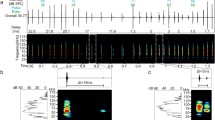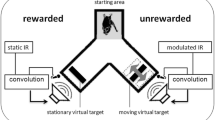Abstract
The big brown bat, Eptesicus fuscus, can perceive small changes in the delay of FM sonar echoes and shifts in echo phase, which interact with delay. Using spectral cues caused by interference, Eptesicus also can perceive the individual delays of two overlapping FM echoes at small delay separations. These results have been criticized as due to spectral artifacts caused by overlap between stimulus echoes and extraneous sounds (Pollak 1993). However, no amplitude or spectral variations larger than 0.05 dB accompany delay or phase changes produced by the electronic apparatus. No reverberation falls in the narrow span of delays required to produce the bat's performance curve from echo interference cues. Consistent differences in the durations of sonar sounds for 6 bats that perform the same in the experiments demonstrate that overlap between stimulus echoes and extraneous echoes is not necessary, and changes in the amount of echo overlap have no effect on performance. Noise-induced random variations in echo spectra outweigh putative spectral artifacts, and deliberately-introduced spectral “artifacts” do not improve performance overall but instead yield new time-frequency images. Amplitude-latency trading of perceived delay, proposed as a demonstration that the latency of neural discharges encodes delay (Pollak et al. 1977), confirms that the bat's fine delay and phase perception depends on a temporal neural code. The perceived delays depend on stimulus delays, not the delays of extraneous sounds. The rejected criticisms are based on physiological results with random-phase FM stimuli which are irrelevant to neural coding of fine echo delay and phase.
Similar content being viewed by others
References
Bodenhamer RD, Pollak GD (1981) Time and frequency domain processing in the inferior colliculus of echolocating bats. Hearing Res 5:317–355
Bodenhamer RD, Pollak GD, Marsh DS (1979) Coding of fine frequency information by echoranging neurons in the inferior colliculus of the Mexican free-tailed bat. Brain Res 171:530–535
Fay RR (1988) Hearing in vertebrates: a psychophysics databook. Hill-Fay Assoc, Winnetka, Illinois
Hartley DJ, Suthers RA (1989) The sound emission pattern of the echolocating bat, Eptesicus fuscus. J Acoust Soc Am 85:1348–1351
Masters WM, Moffat AJM, Simmons JA (1985) Sonar tracking of horizontally moving targets by the big brown bat, Eptesicus fuscus. Science 228:1331–1333
Menne D, Kaipf I, Wagner I, Ostwald J, Schnitzler HU (1989) Range estimation by echolocation in the bat Eptesicus fuscus: trading of phase versus time cues. J Acoust Soc Am 85:2642–2650
Mogdans J, Schnitzler H-U (1990) Range resolution and the possible use of spectral information in the echolocating bat, Eptesicus fuscus. J Acoust Soc Am 88:754–757
Moss CF, Schnitzler HU (1989) Accuracy of target ranging in echolocating bats: acoustic information processing. J Comp Physiol A 165:383–393
Moss CF, Simmons JA (in press) Acoustic image representation of a point target in the FM echolocating bat, Eptesicus fuscus: Evidence for cross-correlation processing. J Acoust Soc Am
Pollak GD (1993) Some comments on the proposed perception of phase and nanosecond time disparities by echolocating bats. J Comp Physiol A 172:523–531
Pollak GD, Marsh DS, Bodenhamer R, Souther A (1977) Characteristics of phasic on neurons in inferior colliculus of unanesthetized bats with observations relating to mechanisms for echo ranging. J Neurophysiol 40:926–941
Saillant PA, Simmons JA, Dear SP, McMullen TA (in press) A computational model of echo processing and acoustic imaging in FM echolocating bats: the SCAT receiver. J Acoust Soc Am
Schmidt S (1992) Perception of structured phantom targets in the echolocating bat, Megaderma lyra. J Acoust Soc Am 91:2203–2223
Schnitzler H-U, Menne D, Hackbarth H (1985) Range determination by measuring time delay in echolocating bats. In: Michelsen A (ed) Time resolution in auditory systems. Springer, New York, pp 180–204
Simmons JA (1979) Perception of echo phase information in bat sonar. Science 207:1336–1338
Simmons JA (1989) A view of the world through the bat's ear: the formation of acoustic images in echolocation. Cognition 33:155–199
Simmons JA (1992) Time-frequency transforms and images of targets in the sonar of bats. In: Bialek W (ed) Princeton Lectures on Biophysics-1991. NEC Research Institute, Princeton NJ
Simmons JA, Chen L (1989) The acoustic basis for target discrimination by FM echolocating bats. J Acoust Soc Am 86:1333–1350
Simmons JA, Grinnell AD (1988) The performance of echolocation: The acoustic images perceived by echolocating bats. In: Nachtigall P, Moore PWB (eds) Animal sonar: processes and performance. New York, Plenum Press, pp 353–385
Simmons JA, Fenton MB, Ferguson WR, Jutting M, Palin J (1979) Apparatus for research on animal ultrasonic signals. Royal Ontario Museum Publications in Life Sciences, Toronto
Simmons JA, Kick SA, Lawrence BD, Hale C, Bard C, Escudié B (1983) Acuity of horizontal angle discrimination by the echolocating bat, Eptesicus fuscus. J Comp Physiol 153:321–330
Simmons JA, Freedman EG, Stevenson SB, Chen L, Wohlgenant TJ (1989) Clutter interference and the integration time of echoes in the echolocating bat, Eptesicus fuscus. J Acoust Soc Am 86:1318–1332
Simmons JA, Moss CF, Ferragamo M (1990a) Convergence of temporal and spectral information into acoustic images of complex sonar targets perceived by the echolocating bat, Eptesicus fuscus. J Comp Physiol A 166:449–470
Simmons JA, Ferragamo M, Moss CF, Stevenson SB, Altes RA (1990b) Discrimination of jittered sonar echoes by the echolocating bat, Eptesicus fuscus: The shape of target images in echolocation. J Comp Physiol A 167:589–616
Stevens SS (ed) (1951) Handbook of experimental Psychology. Wiley, New York
Stevens SS, Newman EB (1936) The localization of actual sources of sound. Am J Psychol 48:297–306
Author information
Authors and Affiliations
Additional information
The contents of this paper first appeared in October 1990 in a letter to G.D. Pollak in response to his unpublished criticisms of echo-jitter experiments. These responses also have been presented at the 1991 and 1992 Association for Research in Otolaryngology midwinter meetings and at the 1992 3rd International Congress of Neuroethology. Several of the control experiments also appeared in Simmons et al. (1990b). The now-published criticisms (Pollak 1993, the preceding paper) have not addressed these responses, including the prior published data demonstrating that the stimulus conditions asserted by these criticisms do not in fact occur.
Rights and permissions
About this article
Cite this article
Simmons, J.A. Evidence for perception of fine echo delay and phase by the FM bat, Eptesicus fuscus . J Comp Physiol A 172, 533–547 (1993). https://doi.org/10.1007/BF00213677
Accepted:
Issue Date:
DOI: https://doi.org/10.1007/BF00213677




